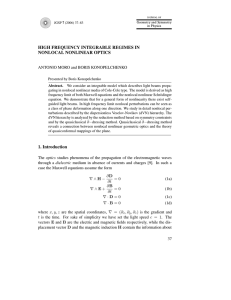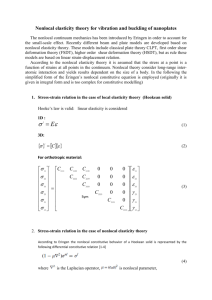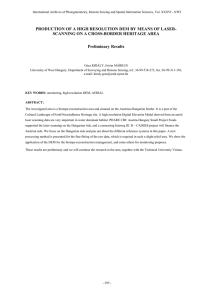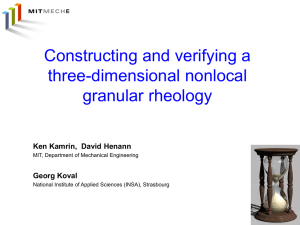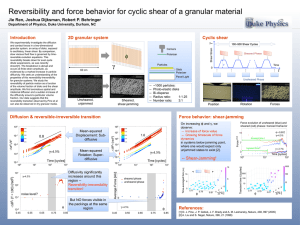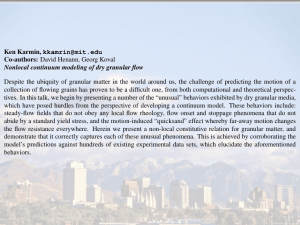Nonlocal Constitutive Relation for Steady Granular Flow Please share
advertisement
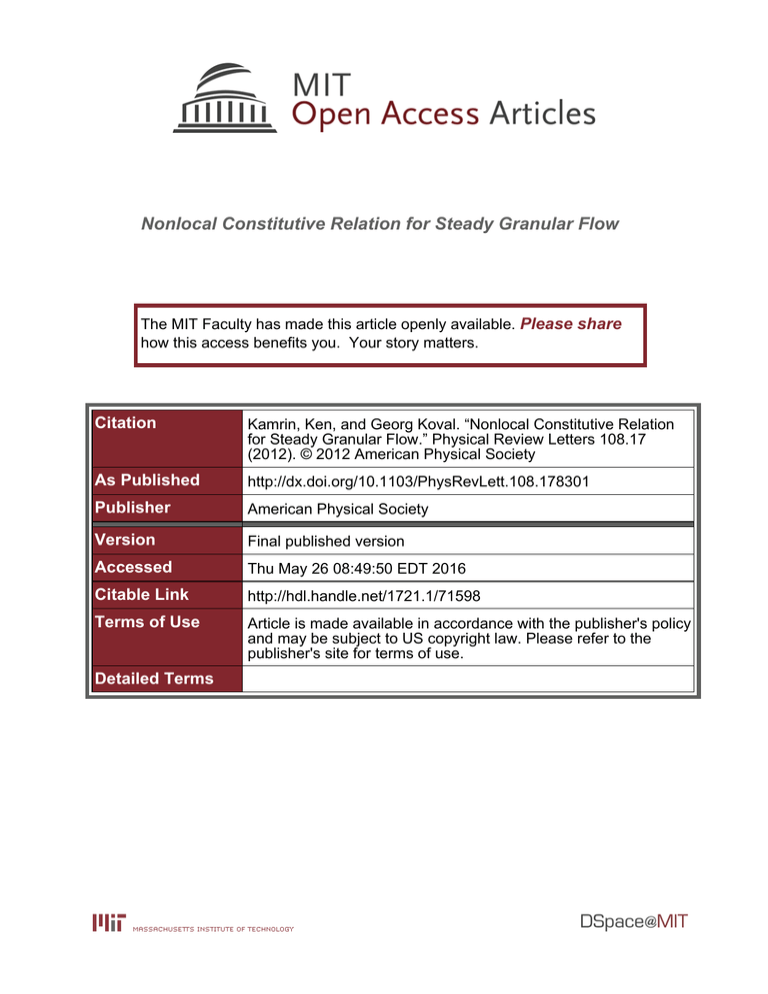
Nonlocal Constitutive Relation for Steady Granular Flow The MIT Faculty has made this article openly available. Please share how this access benefits you. Your story matters. Citation Kamrin, Ken, and Georg Koval. “Nonlocal Constitutive Relation for Steady Granular Flow.” Physical Review Letters 108.17 (2012). © 2012 American Physical Society As Published http://dx.doi.org/10.1103/PhysRevLett.108.178301 Publisher American Physical Society Version Final published version Accessed Thu May 26 08:49:50 EDT 2016 Citable Link http://hdl.handle.net/1721.1/71598 Terms of Use Article is made available in accordance with the publisher's policy and may be subject to US copyright law. Please refer to the publisher's site for terms of use. Detailed Terms PRL 108, 178301 (2012) week ending 27 APRIL 2012 PHYSICAL REVIEW LETTERS Nonlocal Constitutive Relation for Steady Granular Flow Ken Kamrin1 and Georg Koval2 1 Department of Mechanical Engineering, MIT, Cambridge, Massachusetts 01239, USA Laboratory of Engineering Design, National Institute of Applied Sciences, Strasbourg, France (Received 4 January 2012; revised manuscript received 22 February 2012; published 26 April 2012; corrected 1 May 2012) 2 Extending recent modeling efforts for emulsions, we propose a nonlocal fluidity relation for flowing granular materials, capturing several known finite-size effects observed in steady flow. We express the local Bagnold-type granular flow law in terms of a fluidity ratio and then extend it with a particular Laplacian term that is scaled by the grain size. The resulting model is calibrated against a sequence of existing discrete element method data sets for two-dimensional annular shear, where it is shown that the model correctly describes the divergence from a local rheology due to the grain size as well as the rateindependence phenomenon commonly observed in slowly flowing zones. The same law is then applied in two additional inhomogeneous flow geometries, and the predicted velocity profiles are compared against corresponding discrete element method simulations utilizing the same grain composition as before, yielding favorable agreement in each case. DOI: 10.1103/PhysRevLett.108.178301 PACS numbers: 47.57.Gc, 45.70.Mg, 83.10.Ff, 83.80.Fg In homogeneous, steady, 2D simple shearing of a granular material composed of stiff frictional disks, a local rheology emerges of the form ¼ ðIÞ in accord with dimensional arguments, where ¼ =P for shear stress and normal pressure P, and I is the inertial number pffiffiffiffiffiffiffiffiffiffi _ m=P for particle mass m. In simulations of da Cruz et al. [1], the law was quantified and found to be roughly linear, inverted to read IðÞ ¼ Hð s Þð s Þ=b (1) for constant b and static yield coefficient s and Heaviside function H. By isotropic extension, it has been generalized to a three-dimensional form for arbitrary flows and proven effective in certain geometries [2,3]. Nonlocal effects cause divergence from the above law and are most commonly studied in two senses. (i) In inclined plane flow, thin granular layers (measured in terms of d, the particle diameter) require a higher angle of incline before flow ensues. Since is uniform in this geometry, internal strength s could be deemed thickness-dependent in thin granular layers [4] (a property also observed in suspensions [5]). (ii) In large bodies of granular material undergoing steady inhomogeneous deformation, the local law predicts zero flow in regions where < s . However, this is not what is observed; ‘‘subyield’’ regions of < s commonly possess slow flowing material, and the shearrate profile therein has an exponentially decaying character with decay length scaled by the grain diameter [6,7]. It is also observed that shear rate becomes independent of the stress in these quasistatic zones, which defies the clear rate dependence of the local law [8]. In this Letter, we propose and directly test a partial differential equation (PDE) nonlocal flow rule for granular materials aimed at describing steady-flow nonlocality, sense (ii) above. The key novelty of the approach is its 0031-9007=12=108(17)=178301(5) geometric generality, quantitative predictability, and its ability to bridge in one simple form the inertial regime with the quasistatic, including the onset of rate independence and finite-size effects. The model is obtained by extending the nonlocal fluidity approach of Ref. [9], originally used for emulsions. Integral equations have also been used describe nonlocal flow, as in Ref. [10], and can explain sense (i) nonlocality as an effect of a thin domain of integration. On the other hand, a simpler PDE-based rheology can be derived as the ‘‘large-domain’’ limit of an integral law, obtained by integrating over all space after Taylor expanding the integrand. Past PDE-based laws include the theory of partial fluidization [11], kinetic fluctuational theory [12], and the stochastic flow rule [13]. Since nonlocal effects are dominant in slowly flowing zones, the data against which we test our model must be obtained down to very small flow rates, and success is measured by agreement over the entire range of rates. Discrete particle simulations for three different geometries (see Fig. 1) are used for model validation, which can be accurately discerned down to almost arbitrarily small flow rates. The existing model of nonlocal fluidity for a pressureinsensitive emulsion, flow varying only in z, is as follows. _ Define the fluidity by f ¼ =, equivalent to the inverse viscosity. In a homogeneous flow, a known local rheology _ _ _ ¼ ðÞ is obeyed. Thus, f ¼ floc ðÞ ¼ ðÞ=. If the local law has a yield stress y , then floc ð < y Þ ¼ 0. The internal length scale causes the fluidity to be affected by plastic rearrangements nearby. Thus, by defining as the corresponding ‘‘cooperativity length’’ of the plastic deformation mechanism, the fluidity is set to obey f floc ðÞ ¼ 2 @2 f=@z2 : (2) For a known stress field ðzÞ, the full flow solution is given by solving the above and then substituting the solution into 178301-1 Ó 2012 American Physical Society PRL 108, 178301 (2012) week ending 27 APRIL 2012 PHYSICAL REVIEW LETTERS (a mechanical picture common to other nonlocal approaches including Ref. [10]). We adopt their framework by replacing with accordingly, leaving the general form 1 þ Hðs Þ ¼ ðÞ ¼ A d (4) j s j for A a dimensionless scaling constant and d the microlength size (the grain width in our case). The divergence of approaching the yield point is validated by multiple amorphous matter studies [15–17]. Our discrete element method (DEM) data also support this point, as we will see momentarily. As in Ref. [14], the Laplacian can be used to generalize the nonlocal law to two spatial dimensions. Hence, r2 g ¼ FIG. 1 (color online). Geometries being considered, with qualitative depictions indicating the contrast between observed velocity fields (vectors and solid lines) and predictions of the local flow law Eq. (1) (dotted lines). _ ðzÞ ¼ ðzÞfðzÞ to obtain the flow profile. The law is similar to an inhomogeneous Helmholtz equation, which naturally ‘‘diffuses’’ any sharp flow cutoffs in the floc field into exponential-type decay in the f field. However, an equally important (though less appreciated) feature is that the fluidity becomes completely rateindependent whenever floc vanishes. Hence, in regions where < y , the law reduces to f 2 @2 f=@z2 ¼ 0, a linear ordinary differential equation with the property that if fðzÞ solves the system, so does fðzÞ for any scalar . _ Consequently, ðzÞ can be scaled by any multiple, regardless of the stress magnitude, and remain a valid solution. This property characterizes rate independence. Furthermore, the second-order term implies that shear bands never shrink below a finite width governed geometrically by , a well-observed property of steady granular flow. Together with the diffusive character discussed above, the nonlocal fluidity model becomes attractive to adapt for granular materials modeling. Let us define the ‘‘granular fluidity’’ by sffiffiffiffi _ s P g ¼ ! gloc ð; PÞ ¼ Hð s Þ ; (3) m b the latter follows from the local law previously discussed. _ because, as discussed in the We keep the numerator as , theory of fluidity, it must give the time scale of macroscopic deformation; however, the denominator is switched to , because the friction state now determines closeness to yielding. For a quantitative description of , we look to the next advancement in nonlocal fluidity theory [14], which derives as a function of the stress state based on the notion that plastic rearrangements induce stress redistribution 1 ðg gloc Þ: 2 (5) Similarly, we generalize to planar tensorial definitions of qffiffiffiffiffiffiffiffiffiffiffiffiffiffiffiffiffiffiffiffiffiffi ffi P the scalar quantities: _ ¼ 2 D0ij D0ij , P ¼ 12 trðÞ, and qffiffiffiffiffiffiffiffiffiffiffiffiffiffiffiffiffiffiffiffiffiffiffiffiffi ffi P ¼ 0:5 0ij 0ij =P for strain-rate tensor D ¼ 0:5½rv þ ðrvÞT and Cauchy stress , and 0 means the deviatoric part. For now, we study only geometries whose steady flow is incompressible: trD ¼ 0. Interestingly, Eq. (5) has certain similarities with the law governing the order parameter in steady-state partialfluidization theory. Both have a Laplacian term, but in the latter the remaining terms are nonlinear, which prevents direct quasistatic rate independence but allows certain dynamical phenomena in its full form, such as stick-slip behavior. It should also be pointed out that newly developed implicit gradient plasticity models have also exploited a state variable obeying a law like Eq. (5) but with ‘‘fictitious plastic strain’’ replacing the fluidity [18]. Our model [Eqs. (3)–(5)] requires four total modeling parameters to characterize the granular matter. We use b ¼ 1:05 and s ¼ 0:26 from existing planar shear data utilizing the same DEM disk properties. While the theory for emulsions gives ¼ 0:5, we find that ¼ 0:6 gives a better fit to data and shall use this number. We also find A ¼ 0:31 to be a good choice. These numbers are used for all calculations in this Letter. We check our model against DEM simulations, which follow the same scheme precisely described in Ref. [8]; the material is composed of 20% polydisperse disks with mean diameter d, mean mass m, surface friction c ¼ 0:4, contact elastic stiffnesses kn 104 P (corresponding to stiff particles), kt ¼ 0:5kn , and restitution coefficient e ¼ 0:1. We use MATHEMATICA 10 to compute high-precision numerical solutions for the model, straightforward because the model reduces to an ordinary differential equation in spatially symmetric geometries as we consider here. The geometries we consider have simple stress fields, which we use as the input to solve for g. In the DEM simulations, the velocity of the wall and that of the free material adjacent to 178301-2 PRL 108, 178301 (2012) PHYSICAL REVIEW LETTERS it are frequently mismatched due to imperfections in attaining a fully rough condition, so, while we use the Vwall as a reference value, our actual PDE boundary values utilize that of the adjacent mobile material and not the wall itself. Because of the immobility of wall particles, we postulate that granular fluidity at the boundaries gwall is a function of the local stress state and have found gwall ¼ gloc to be appropriate for fully rough walls (as in Refs. [9,18,19]) or in general for flows where the inertial number I is large near the walls. However, an in-depth future study is necessary to fully quantify the boundary conditions. We first test our model rheologically, by comparing against the detailed report by Koval et al. [8] for DEM simulations of the annular shear cell. The geometry has two concentric fully rough walls. The inner wall at r ¼ R is rotated at a fixed rate (i.e., Vwall ¼ R), and the outer wall at r ¼ 2R is prevented from rotating but permits some inward wall movement to provide a fixed inward pressure Pwall (force per length). In the steady state, moment balance gives r ðrÞ ¼ SðR=rÞ2 for inner wall shear stress S, and the normal components are observed (through coarsegraining) to obey ðrÞ rr ðrÞ Pwall to a good approximation throughout. Hence we have PðrÞ ¼ Pwall and ðrÞ ¼ jr ðrÞ=Pwall j. The first data against which we test are a set of steadyflow simulations conducted for different choices of the size ratio R~ ¼ R=d with fixed normalized inner wall speed pffiffiffiffiffiffiffiffiffiffiffiffiffiffiffiffiffiffiffiffiffiffiffi V~wall ¼ Vwall m=ðd2 Pwall Þ ¼ 2:5. In each run, when the steady state is reached (taken as V~wall t 100, where t is the simulation time), coarse-grained ðI; Þ pairs from radial positions r (see [8] for the averaging method) are plotted [see Fig. 2(a)]. For large values of I, the vs I data appear to collapse onto a single curve aligned with the local law. For smaller I, the different tests split off from a single curve in a clear fashion, demonstrative of the size effect. The model captures this effect and simultaneously gives the usual local law under homogeneous planar shear conditions, matching data from Ref. [1]. It can be understood that regions of large I tend to the local law because g gloc ðÞ2 r2 g in zones of large . We plot corresponding velocity profiles in Fig. 3(a). As discussed in Ref. [8], the material far from the inner wall is not yet in the steady state, and hence our velocity predictions are inferiorly limited by the lowest velocity value (in steadystate range) available for each profile. Another nonlocal aspect is probed by varying V~wall at fixed R~ ¼ 50. The model solutions are plotted against those of the DEM in Fig. 2(b). The DEM results show clear rate independence; as wall speed decreases, a nearly identical range of values corresponds to a completely different range of I for each run. Hence, ðrÞ ! s ðR=rÞ2 , below s almost everywhere, while the scaled flow rate _ field ðrÞ= _ wall approaches a seemingly fixed, nowherevanishing distribution. This result is also outside the realm week ending 27 APRIL 2012 FIG. 2 (color online). vs I locus in steady annular shear: (a) Nonlocal model (solid lines) compared to DEM for V~wall ¼ 2:5 and R~ ¼ 25 (h), 50 (e), 100 (4), and 200 (). (b) Comparisons for fixed R~ ¼ 50 and V~wall ¼ 0:000 25 (h), 0.0025 (5), 0.025 (), 0.25 (4), and 2.5 (e). The local rheology (dotted line) is indicated, to which the nonlocal model approaches only in uniform stress environments [e.g., planar shear, DEM data (w) of Ref. [8]]. of local rate-independent models; for example, critical state soil plasticity would require a single value in the steady-flowing zones of an annular shear, but here a range of steady values is present. With rheological validation in hand, we take the same model, predict flow profiles in different geometries, and compare results to new DEM simulations. In order to decrease the observed disturb of the velocity profiles near the walls, we adopt rough walls composed by particles with a diameter twice as large as the tested material. First, we predict flow in a simple shear geometry with gravity pointing downward, orthogonal to the shear direction. The apparatus has height H ¼ 40d, top and bottom rough walls, and periodic boundary conditions on the sides. A pressure Pwall is applied to the top surface, and the top wall is given a dimensionless lateral velocity of V~wall ¼ 2:5. 178301-3 PRL 108, 178301 (2012) PHYSICAL REVIEW LETTERS FIG. 3 (color online). (a)–(c) DEM velocity profiles (symbols) vs nonlocal model (solid lines). (a) Annular shearing (DEM data from Ref. [8]): V~wall ¼ 2:5 and R~ ¼ 25 (e), R~ ¼ 50 (5), R~ ¼ 100 (h), and R~ ¼ 200 (). (b) Planar shear with gravity: ~ g ¼ 0:04 (e), 0.08 (v), and 0.16 (). V~wall ¼ 2:5 and w ~ g ¼ 0:0175 (4), 0.02 (), and (c) Vertical chute flow: w 0.0225 (h). (d) Direct measurement of 2 =d2 [by Eqs. (3) and (5)] vs from the DEM flow profiles in each geometry: Annular ~ g ¼ 0:04 shear R~ ¼ 50, V~wall ¼ 2:5 (5), shear with gravity w ~ g ¼ 0:225 (h). The solid line shows (), and vertical chute w theoretical result using ðÞ from Eq. (4). week ending 27 APRIL 2012 The wall shear stress S induced by the motion sets the shear stress throughout: xy ðyÞ ¼ S. If we define a mean solid fraction m , we can define the normalized weight density ~ g ¼ 4mGm =ðPwall dÞ. The of the granular media as w vertical compressive stress increases downward due to ~ g y=dÞ. As before gravity, giving yy ðyÞ ¼ Pwall ð1 þ w in the Couette cell, we assume yy ðxÞ xx ðxÞ, which turns out to be well matched by the DEM. Likewise, ~ g y=dÞ. We run DEM simulations ðyÞ ¼ S=½Pwall ð1 þ w ~ g (0.04, 0.08, and 0.16). for different values of w Comparisons between the DEM and nonlocal model’s flow fields are presented in Fig. 3(b). Next, we consider gravity-driven flow down a long vertical chute with rough parallel walls. The walls are separated by a distance L ¼ 40d, and a wall pressure Pwall is applied. The simulation utilizes periodic boundary conditions at the top and bottom of the chute, implying the Janssen limit where stress be~ g x=d comes vertically invariant. Likewise, xy ðxÞ ¼ Pwall w by vertical force balance, and, indeed, we see this formula upheld extremely well in the stress field obtained from the DEM simulations. Again, yy ðxÞ xx ðxÞ ¼ Pwall , which gives ðxÞ ¼ jxy ðxÞ=Pwall j. We solve Eq. (5) as an ordinary differential equation in x given the stress field ~ g . Figure 3(c) demonas determined from the choice of w strates that the nonlocal model captures the velocity field [displayed relative to the center velocity vy ðx ¼ 0Þ ¼ vcen ] ~g over several orders of magnitude for different values of w (0.0175, 0.02, and 0.0225). While we desire the simplest possible flow relation, quantitative accuracy is lost when assuming const as in Ref. [9]; for any single value, we always find noticeable deviations in the majority of test cases when plotted as in Figs. 3(a)–3(c). Rather, Fig. 3(d) shows the -dependent nature of by comparing DEM values inferred by using Eqs. (3) and (5) to the relation in Eq. (4). An empirical fit for ðÞ could be made to match data better for > s ; however, this is the inertial range where has minimal effect, and we prefer to keep with Eq. (4) for its connection to existing theory. Also, in view of our observation that steady-flow normal stresses along and perpendicular to the shear plane are approximately equal (also observed in Refs. [1,20]), it seems that the most general form would be to append the coaxial flow condition D=jDj ¼ 0 =j 0 j to the system, which closes the system of equations for arbitrary geometries. Solutions could be computed by including a small elastic component to the deformation and going to the steady state with an elastoplastic finiteelement solver, as done in Ref. [3], with g added as a nonlocal state variable. We should also point out that, in focusing on the steady state, we leave out a description of possible transient behavior; an unsteady version of Eq. (5) _ in line with other ought to include a term proportional to g, approaches to nonlocal flow [11]. A study of the relationship between the grain properties and the nonlocality parameters would be interesting future work. Last, this model 178301-4 PRL 108, 178301 (2012) PHYSICAL REVIEW LETTERS treats packing fraction as a ‘‘slave variable,’’ because, in the steady state, the work of Ref. [1] shows ¼ ðIÞ even in inhomogeneous flow geometries [8]. However, for transient analysis, a correct update of and its effect on s would be necessary. [1] F. da Cruz, S. Emam, M. Prochnow, J. Roux, and F. Chevoir, Phys. Rev. E 72, 021309 (2005). [2] P. Jop, Y. Forterre, and O. Pouliquen, Nature (London) 441, 727 (2006). [3] K. Kamrin, Int. J. Plast. 26, 167 (2010). [4] L. E. Silbert, J. W. Landry, and G. S. Grest, Phys. Fluids 15, 1 (2003). [5] C. Bonnoit, T. Darnige, E. Clement, and A. Lindner, J. Rheol. 54, 65 (2010). [6] G. D. R. Midi, Eur. Phys. J. E 14, 341 (2004). [7] D. M. Mueth, Phys. Rev. E 67, 011304 (2003). [8] G. Koval, J.-N. Roux, A. Corfdir, and F. Chevoir, Phys. Rev. E 79, 021306 (2009). week ending 27 APRIL 2012 [9] J. Goyon, A. Colin, G. Ovarlez, A. Ajdari, and L. Bocquet, Nature (London) 454, 84 (2008). [10] O. Pouliquen and Y. Forterre, Phil. Trans. R. Soc. A 367, 5091 (2009). [11] I. S. Aranson and L. S. Tsimring, Phys. Rev. E 64, 020301 (2001). [12] S. B. Savage, J. Fluid Mech. 377, 1 (1998). [13] K. Kamrin and M. Z. Bazant, Phys. Rev. E 75, 041301 (2007). [14] L. Bocquet, A. Colin, and A. Ajdari, Phys. Rev. Lett. 103, 036001 (2009). [15] G. Lois and J. M. Carlson, Europhys. Lett. 80, 58 001 (2007). [16] G. Picard, A. Ajdari, F. Lequeux, and L. Bocquet, Phys. Rev. E 71, 010501 (2005). [17] A. Lemaitre and C. Caroli, Phys. Rev. Lett. 103, 065501 (2009). [18] L. Anand, O. Aslan, and S. A. Chester, Int. J. Plast. (to be published). [19] R. A. B. Engelen, M. G. D. Geers, and F. P. T. Baaijens, Int. J. Plast. 19, 403 (2003). [20] L. E. Silbert, D. Ertas, G. S. Grest, T. C. Halsey, D. Levine, and S. J. Plimpton, Phys. Rev. E 64, 051302 (2001). 178301-5
